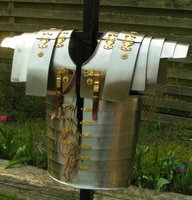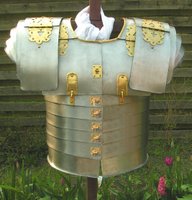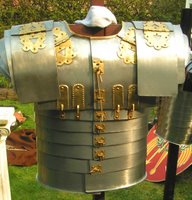Lorica Segmentata
Den romerske Lorica Segmentata var på alle måder en banebrydende opfindelse. Lorica Segmentata afløste i store træk ringbrynjen (Lorica Hamata) for den professionelle Legionær, selvom begge rutningstyper fortsat blev brugt. De tidligste eksemplarer af Lorica Segmentata kendes fra Augustus tid. Segmentata var på alle måder genial. Den var nemmere og billigere at fremstille og den beskyttede bedre mod pile, spyd og slag end en ringbrynje, da pladerne - der var fremstillet af “blødt” pladejern - kunne absorbere stød og hug fra sværd og pile, hvor ringbrynjen ikke gav nogen beskyttelse.
Lorica Segmentata blev brugt frem til slutningen af 2 århundrede. Hvor recession i Romerriget generelt og i hæren i særdeleshed, gjorde at ringbrynjen igen vandt indpas.
En lignende pladebrynje blev ikke siden brugt, før et godt stykke inde i middelalderen.
The Roman Lorica Segmentata was in all perspectives a Poineering Invention. Lorica Segmentata relieved in large scale the Lorica Hamata – the mail armour – in the Standing Legions. But both types kept in use at the same time. The earliest editions of Lorica Segmentata is from the Augustan period.
Lorica Segmentata was in every way brilliant. It was easy and cheap to manufacture and gave much better protection againt spears, arrows and swordcuts than a mail armour.
Lorica Segmentata was made of a “soft” ironplate, wich could absorb hits and blows were the mail gave no protection.
Lorica Segmentata was used until the end of the 2. Century. Where the general Resession in the Empire and especially in the Army, gave way for the return of mail armour.
A similar Armour like the Lorica Segmentata did not come in use before the High Middleages.



Newstead Segmentata fra 2. Århundrede (Ca. Marcus Aurelius). Pladerne er blevet større og enklere, og der er færre af dem. De holdes nu sammen af beslag og metalkroge, da man havde erfaret af rustningerne faldt fra hinanden hvis læderremmene blev hugget over.
Newstead Segmentata from the 2. Century (Ca. Marcus Aurelius). The plates are big and fewer.
They are now attached with metal hooks and rings, because of the experience of the leathersstraps being cut in battle, and so opening the Lorica.
Lorica Segmentata blev brugt frem til slutningen af 2 århundrede. Hvor recession i Romerriget generelt og i hæren i særdeleshed, gjorde at ringbrynjen igen vandt indpas.
En lignende pladebrynje blev ikke siden brugt, før et godt stykke inde i middelalderen.
The Roman Lorica Segmentata was in all perspectives a Poineering Invention. Lorica Segmentata relieved in large scale the Lorica Hamata – the mail armour – in the Standing Legions. But both types kept in use at the same time. The earliest editions of Lorica Segmentata is from the Augustan period.
Lorica Segmentata was in every way brilliant. It was easy and cheap to manufacture and gave much better protection againt spears, arrows and swordcuts than a mail armour.
Lorica Segmentata was made of a “soft” ironplate, wich could absorb hits and blows were the mail gave no protection.
Lorica Segmentata was used until the end of the 2. Century. Where the general Resession in the Empire and especially in the Army, gave way for the return of mail armour.
A similar Armour like the Lorica Segmentata did not come in use before the High Middleages.

Corbrigde A Segmentata fra 1. Århundrede (Ca. Vespasian). Pladerne holdes sammen med læderremme og er små og meget mobile.
Corbrigde A Segmentata . from the 1. Century. (Ca. Vespasian) The plates are small and very mobile, and fitted with leatherstraps.


Newstead Segmentata fra 2. Århundrede (Ca. Marcus Aurelius). Pladerne er blevet større og enklere, og der er færre af dem. De holdes nu sammen af beslag og metalkroge, da man havde erfaret af rustningerne faldt fra hinanden hvis læderremmene blev hugget over.
Newstead Segmentata from the 2. Century (Ca. Marcus Aurelius). The plates are big and fewer.
They are now attached with metal hooks and rings, because of the experience of the leathersstraps being cut in battle, and so opening the Lorica.


1 Comments:
Nice!
Post a Comment
<< Home